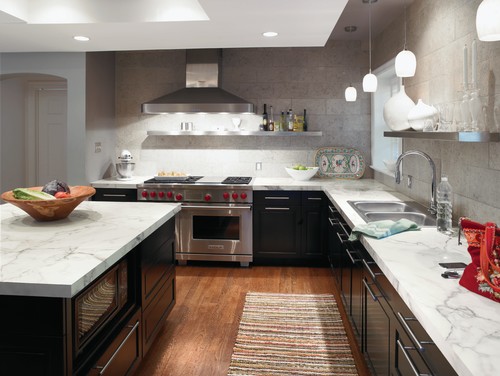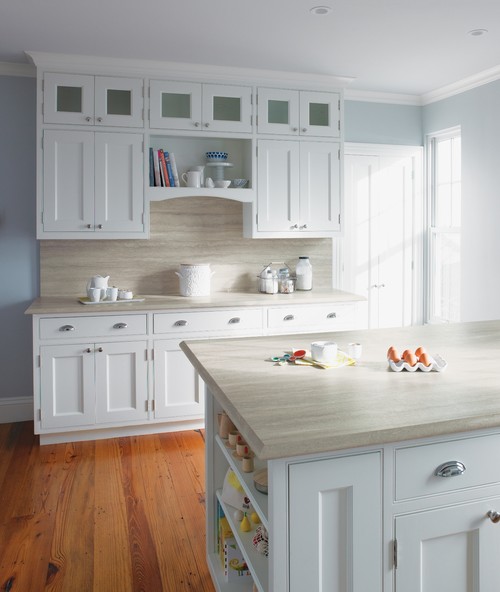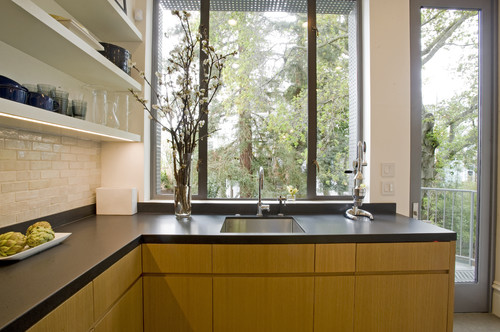Design Dilemma: No more lamenting laminates!
Laminate has come a long, long way from the cheesy material we associate with cheap 1960s kitchens. The laminate of yesteryear would crack easily, harbor dirt and grime at joints, and was pretty limited in terms of style and color. Well, times have changed, and today, you can find laminates for every look and every budget.
Plastic laminate countertops are actually a wafer-thin finish adhered to a plywood or particleboard substrate. The thin finish is a high-pressure laminate (HPL) made of three layers of material bonded together by high heat and pressure: a clear melamine top for protection, a decorative layer and a backing made of phenolic resin-coated kraft paper. Well-known laminate manufacturers include Formica, Wilsonart and Nevamar. You can expect to pay $8 to $30 per square foot, substantially less than what you might pay for granite, quartz or marble. The best thing about today’s laminate is that the edges have substantially improved. You are no longer stuck with that ugly brown line at the edge of countertops.
In addition, laminates are much more sustainable than they used to be. Manufacturers like Formica and Wilsonart have boosted the sustainability of their products with the use of FSC-certified wood. And several manufacturers can boast of GreenGuard certification, which indicates that their products contribute to improved indoor air quality.
Let’s take a look:
High definition laminate
Although the above countertop may look like stone, it’s actually a new high-definition laminate from Formica. In person, this laminate has a glittering, prismatic effect that makes it look even more like natural stone than it does in this photo.
Travertine-look
Above, is a laminate that looks just like travertine. It’s 3458 Travertine Silver with Ogee IdealEdge™ (180fx® laminate).
Granite-look.
Stone-like
This is Formica’s 3420-46 Dolce Vita in Etchings™ finish with Bullnose IdealEdge™ (180fx® laminate). The great thing about this sort of edge is that it looks like natural stone and lacks the edges where dirt and grime can collect.
About edges
Your options have improved dramatically from the edging of yesteryear. Today, you can choose from:
- Profiled edge: Laminates have advanced to now have beveled, ogee and bullnose edge profiles, which vary by manufacturer.
- Edge band: These thick and dense veneers are adhered to the cabinet edge and are made for abuse. Choose ABS plastic edge bands over PVC whenever possible, as ABS is recyclable and chlorine free.
- Metal edge: A retro detail harking back to the 1950s; a metal edge is fastened to the edge of the counter. There is a downside — crumbs and food particles can get stuck in these edges.
- Exposed plywood: Some modern designs showcase the thin laminate veneer and adhere it to premium plywood, leaving the thin veneer edge and plies exposed.
Here’s an example below on a wood-look laminate with an exposed plywood edge below:
Laminates are virtually maintenance free but that doesn’t mean they require no care whatsoever. They can easily be cleaned with just a damp cloth or sponge and mild detergent. However, avoid bleach, as it can cause discoloration. Be sure to use a cutting board, since knives can leave irreparable scratches and marks. Be sure to use trivets, since lamination is only resistant up to 150 degrees.
So there’s no reason any longer to feel embarrassed about your laminate countertops. Laminates can be just as stylish, sophisticated and sustainable as other materials. There’s no longer a reason to lament laminates!
A Renaissance Piazza – Contemporary Portuguese Minimalism
Here’s a lovely house in Portugal from Intergaup with the timeless serenity of a Fra Angelico piazza in a Renaissance painting.
The design pays homage to traditions that go back to medieval architecture.
Traditional materials like the terracotta tile roofline integrate the house into its rural context near Villa Boim.
Blending strict traditions with a contemporary architectonic approach results in beautiful and almost surreal spaces.
The body of water, the retaining wall and the stair exemplifies the drawing and the purity in the details,.
The main house has only one floor in a “U” shape. The U has its back facing against the slope, creating an inner courtyard.
The view from each angle is perfection.
Yet the plan shows no indication that every view is perfectly drawn.
An iconic white stairway connects the courtyard to the higher ground above the house on the hillside.
Rustic twigs provide protection and shade from the hot Portuguese sun.
The deeply shadowed interiors stay cool the old fashioned way.
A dark interior with stone floors provides relief from the blazing heat outside. Read the rest of this entry »
Former WWII Arsenal Transforms into a Cosy Mountain Retreat
A Swiss arsenal from WWII is transformed by Ralph Germann architectes into a warm and comfortable mountain chalet.
Keeping the historic nature of the building with the use of simple materials, like larch, slate, glass, and metal, a cosy mountain cabin retreat is created.
The key to the design is an entirely glazed interior box – with full height sliding doors – within the original army building.
The glass box makes it possible to entirely open the barn doors outside, while a glass box keeps the interior cosy, while preserving the historic building shell.
The generous exterior barn doors – and the glass interior door – can be open when the mountain sun is available.
But in cold weather, the interior sliding glass door in front of the barn door opening is closed. Read the rest of this entry »























